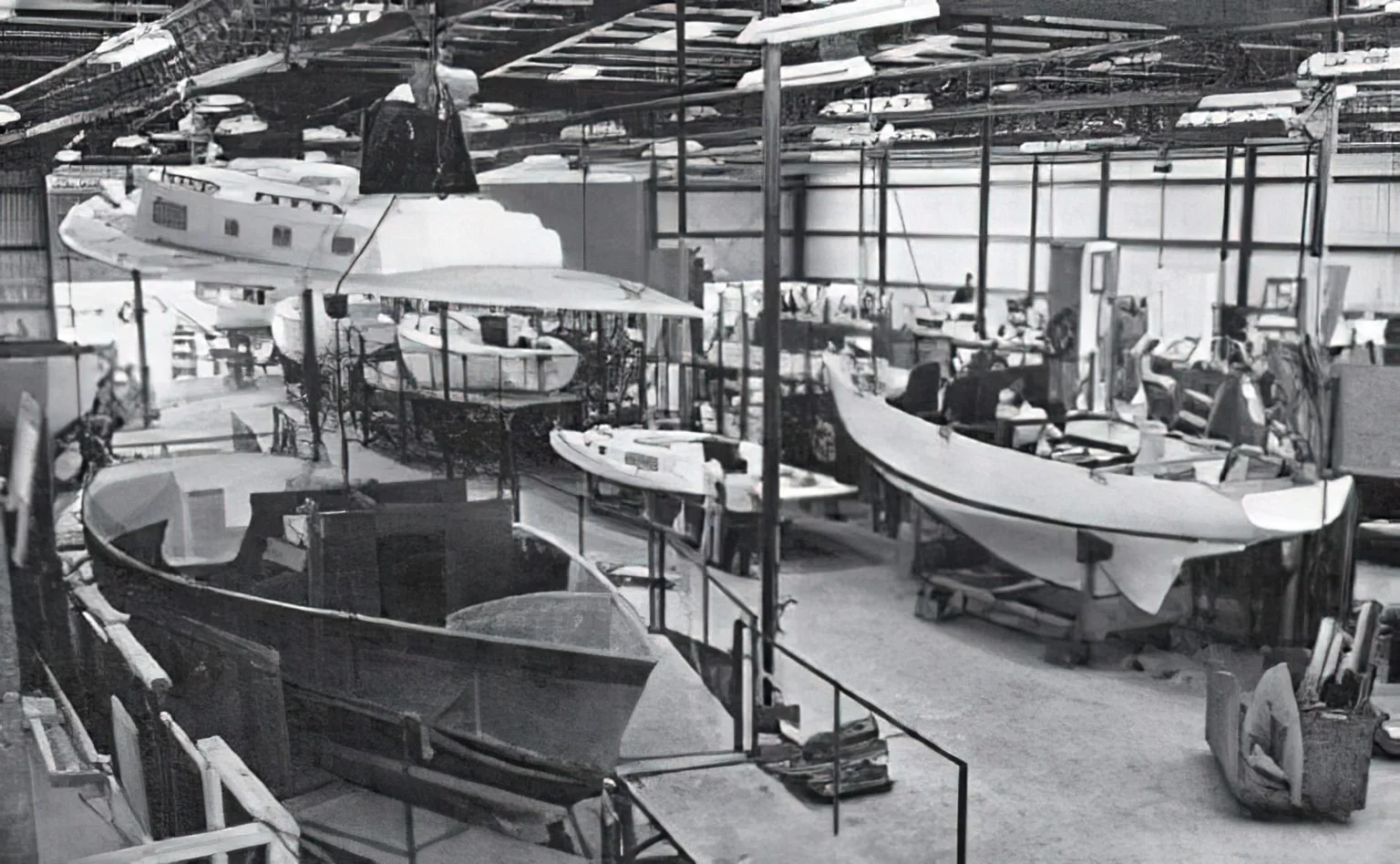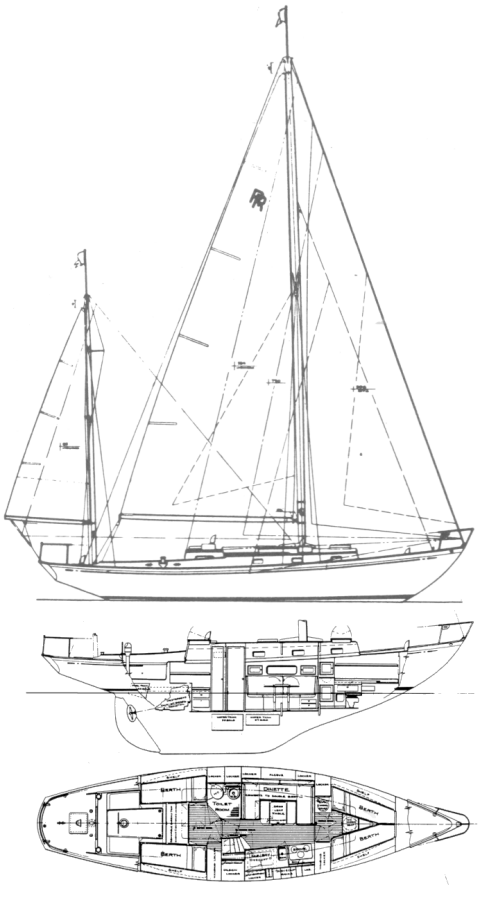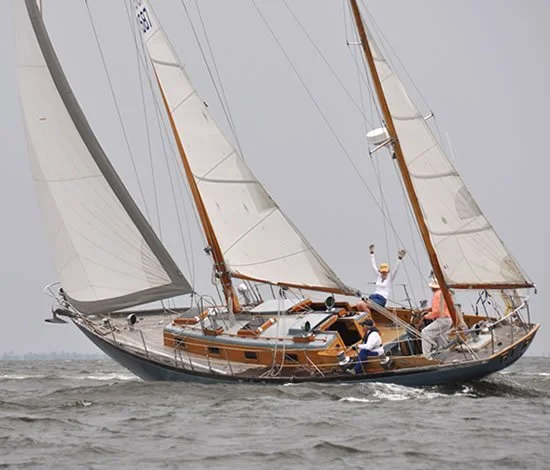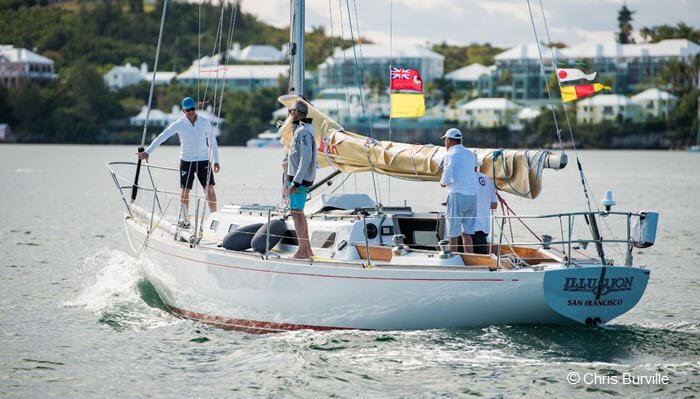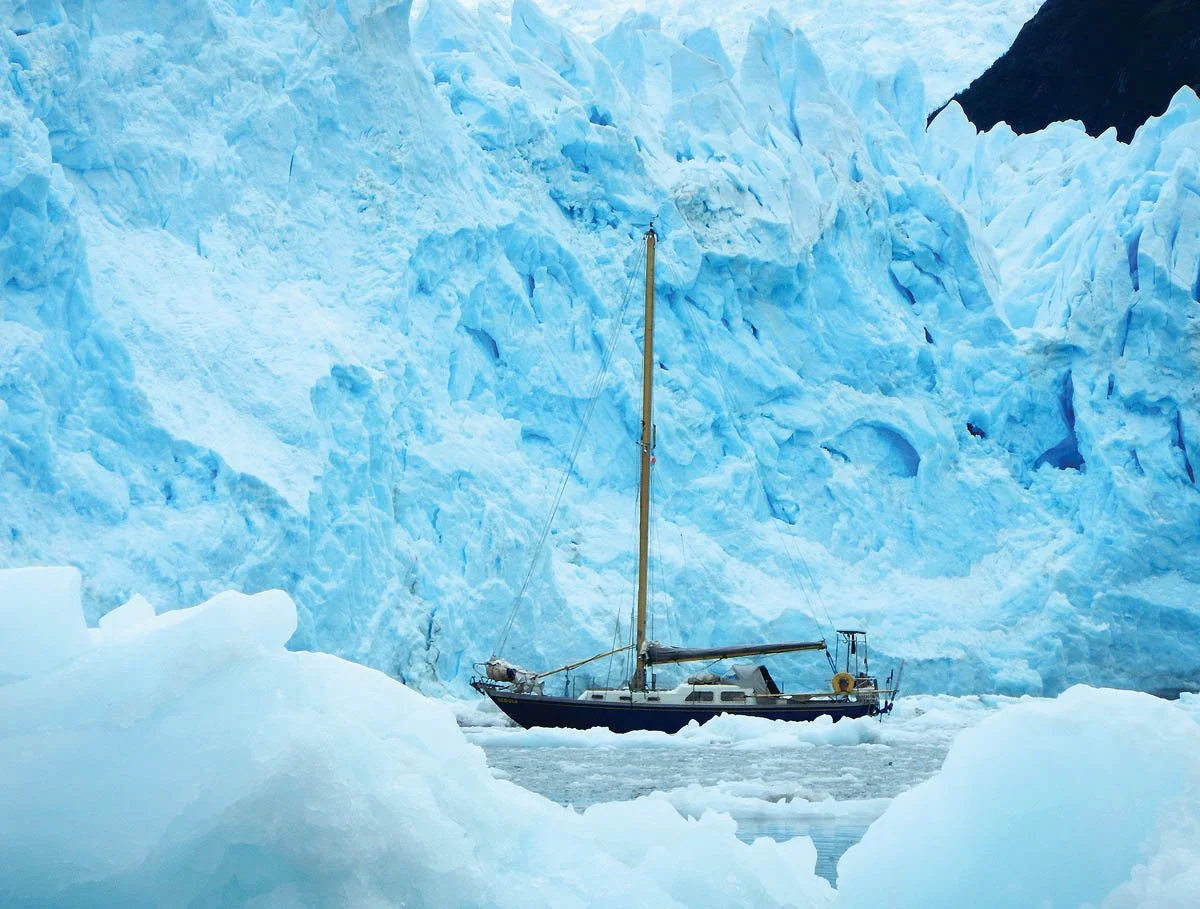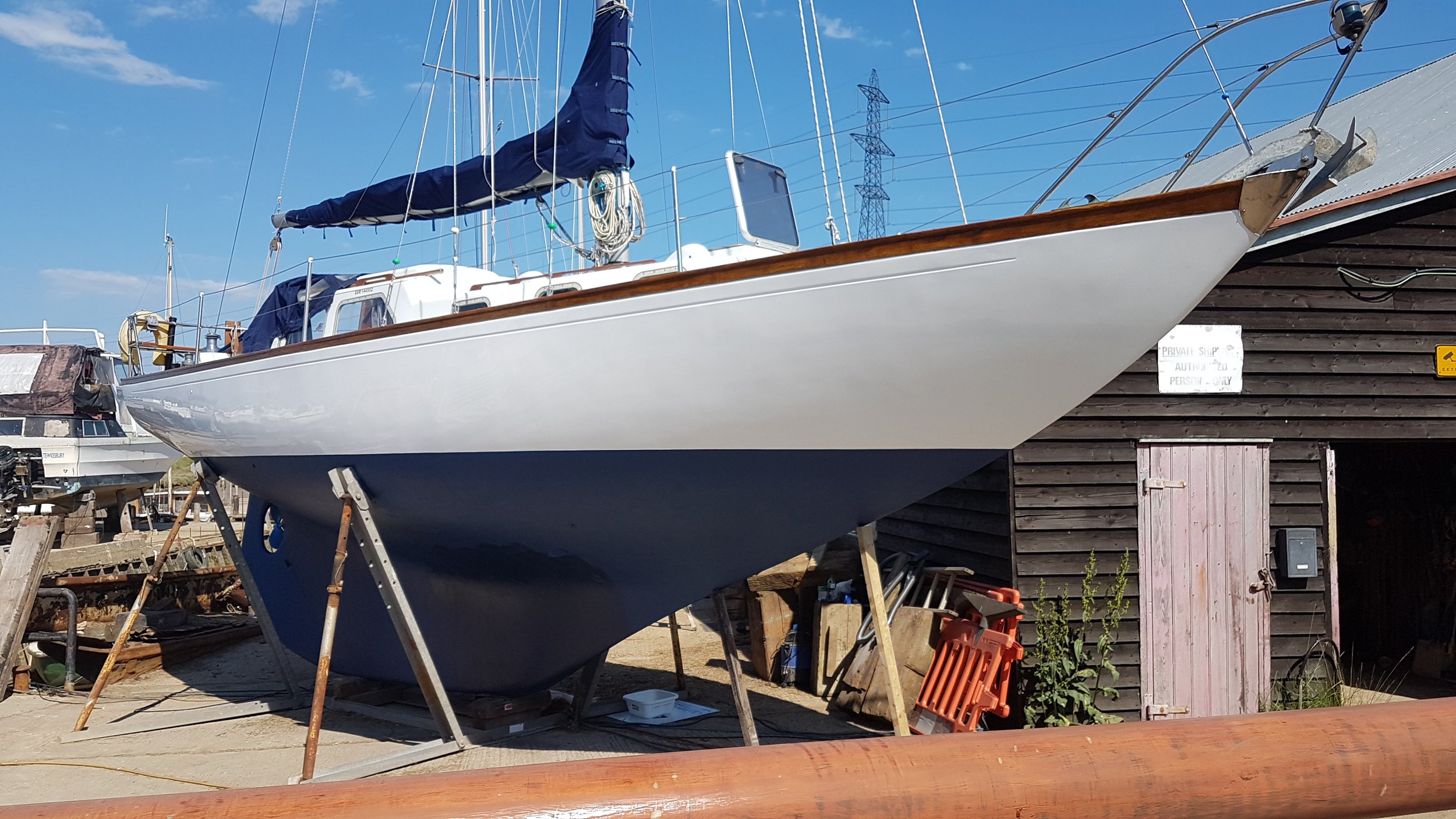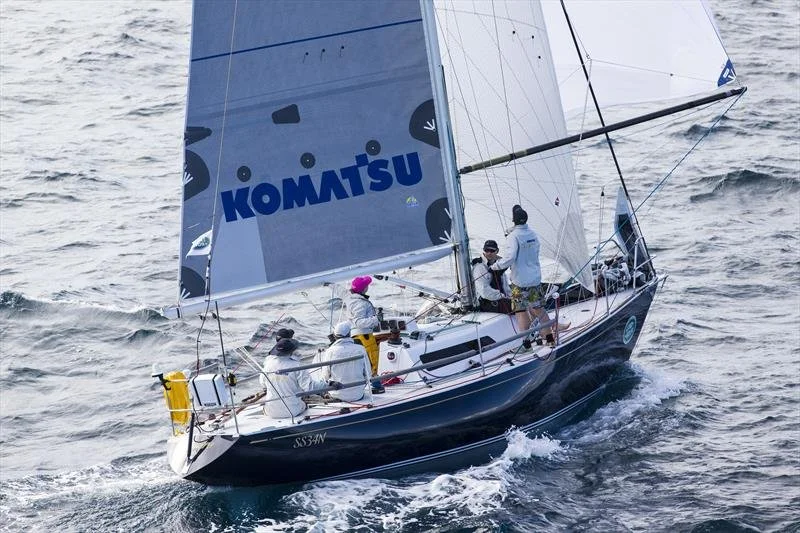Including GRP Icons?
There is often an under lying tension with Classic Sailing Regattas and Association memberships, when it comes to deciding what sort of boats should be accepted.
Morgan Yachts’ St. Petersburg, Florida late 1950’s
Personally, I’m of the opinion that we can’t afford to be anything but inclusive at every opportunity. This is the attitude that the New Zealanders take with many GRP boats of classic design competing in their Classic events. Here in Australia the CYAA has a different view with GRP boats being excluded from recent Classic regattas. It’s a policy that’s going to make building active and diverse communities around traditional craft harder and harder in years to come.
Despite the fact that we call this website “Southern Woodenboat Sailing”, I believe we should be judging the physical design of the boats that we choose to include, their achievements and most importantly the values that they bring to sailing, rather than just the material they are made out of. Remember, the first fibreglass production yachts were made about 65 years ago, before many of us were born.
We all love a list so here are my top five Classic fibreglass production boats
The criteria I have applied are are…
Under 45ft
Large production runs
Designed as a GRP boat (not just a plastic version of a perfectly good wooden design (eg VERTUE/H28)
Number Five-THE RHODES RELIANT
This design makes it into my top five list for a couple of reasons. It is generally seen as the first successful attempt to design and build a “mass” production yacht. The second reason is a little less rational. Having owned a yacht from the same designer, of similar length, rig and era for almost 25 years… I’m biased!
From Cruising World Magazine 2018-
Philip Rhodes, the famous yacht designer, was always up for a challenge, but he might have surprised even himself when asked to create a three-cabin cruiser under 41 feet LOA. “You can’t do it,” Rhodes reportedly told David Toombs, founder of Lion Yachts in Greenwich, Connecticut. Toombs, a former Pan Am airline pilot, had discovered Cheoy Lee, the Hong Kong shipyard that produced great yachts for less, but then learned that shipping a boat longer than 41 feet would significantly raise the cost. “Just give it a try,” Toombs replied.
Sketching lines from his earlier hulls, adding copious amounts of teak, wood masts, and a unique interior with a starboard entry and companionway, Rhodes created the Reliant, a classic plastic that looked like a classic wood yacht. It became “perhaps the most admired and sought-after fiberglass boat from the board of Phil Rhodes,” writes Richard Henderson in his authoritative Philip L. Rhodes and his Yacht Designs (International Marine, 1993). Forty-four Reliants were produced between 1963 and 1968.
As an early fiberglass design — 40 feet 9 inches in length, a 28-foot waterline, a 10-foot-9-inch beam and 5-foot-9-inch draft — the Reliant’s hull is massively thick. With solid teak interior, cabin trunk and deck, wood spars (most were yawls), bronze and stainless hardware, and 4 tons of lead ballast, the boat displaced ten tonnes. The combination yielded an oceangoer known both for its exquisitely balanced sheer lines and for its stable, easy-riding motion.
But it is the interior layout that owners rave about. Below the cockpit is a private owners suite with twin bunks, chart table, electronics and its own head with shower. Descending from the cockpit through a starboard hatch, curved steps lead to a companionway that goes forward on the right of center, with the galley along the starboard hull, and a large table/bunk to port. A V-berth forward has a second head. The layout provides “remarkable privacy” but also a sense of spaciousness rare in a narrow hull. (click to enlarge)
Number Four-Cal 40
There may be no more than a handful of sailboats in recent history that can be called milestones in that they significantly influenced the way in which boats were designed, built and sailed. Without a doubt, the Cal 40 is one design that fits this elite group.
Introduced in 1963, the Cal 40 was so successful competing under the Cruising Club of America handicap rule that there are some who blame the design for the demise of the CCA rule and rise in popularity of the European-influenced IOR rule. The IOR was not kind to the Cal 40, and production ended in 1972 after about 170 boats had been built.
The Cal 40 was a collaboration of designer Bill Lapworth, California sailor George Griffith and Jack Jensen, owner of Cal-Jensen Marine of Costa Mesa, CA. Principal dimensions are 39’4" LOA, 30’4" LWL, 11’ beam, 5’7" draft and 15,000 displacement. Although Lapworth was not the first to conceive of them, many features of the Cal 40 design were a considerable departure from what was conventional wisdom of the time. Displacement was 25 percent below the norm, and the waterline length was 10 percent greater than similar sized boats of the day. Her fin keel, spade rudder, flat bottom, and hard bilges were radical departures from what was then considered safe and prudent for offshore yachts.
The Cal 40 was one of the best performing sailboats of her time, and even today she is likely to embarrass some newer designs particularly in heavy air off the wind where she still shines. Because her bottom is quite flat, she can pound and be wet in adverse conditions. She doesn’t point as well as more modern fin keel designs with higher aspect rigs, but she balances very well and is easily sailed. (click to enlarge)
Number Three- Nicholson 32
Image-Genevieve Leaper
From Practical Boat Owner -2020
The Nicholson 32 was one of the first production-built GRP yachts of its size. It quickly gained a reputation for being an ultimate go-anywhere cruiser that was also fitted out to a high standard. Some 370 were built over an 18-year period, following the launch of the prototype in 1963, and examples have ventured to all parts of the globe.
Well known boats include Claire Francis’s Gulliver G, a 1966 model in which she completed her first solo Atlantic crossing in 1973.
More recently, Tony Curphey briefly became the oldest person to complete a non-stop circumnavigation via the Southern Ocean on board Nicola Deux when he completed the Longue Route.
The boat was the result of a partnership between pioneering glassfibre moulding company Halmatic and the Camper & Nicholson design office and shipyard. It was designed by Charles A Nicholson and his son Peter, whose family had an enviable reputation for yacht design, including America’s Cup challengers Shamrock and Endeavour, plus a long string of desirable custom ocean racing and cruising yachts.
Very heavy displacement was married to a high ballast ratio, slender beam and ‘a cod’s head and mackerel tail’ hull form. This shape, with full forward sections and relatively slender aft, had long been believed by British designers to produce a fast and sea kindly hull. And it creates more forecabin space than might be expected given the Nic 32’s relatively narrow overall beam.
In the early 1960s no one knew how strong glassfibre boats needed to be and construction is of massively thick chopped strand mat. It’s a crude construction by today’s standards, but benefits from being strong and easily repaired.
Part of the reason for the boat’s long-standing sales success was a constant stream of improvements, modifications and updates, with new versions launched for almost every London boat show during the 1960s.
“The Nicholson 32 is a lovely boat to sail. Her deep long hull with over three tonnes of lead ballast takes her through seas without bouncing around or slapping the water, although her low freeboard means the toe-rails sometimes get wet. She is comfortable for two, although comfort is a relative term. She was built at a time when people wanted adventure on the water, rather than a chilled Chardonnay tied to a pontoon.”
Number Two- S&S 34
Image-Andrea Francolini
Perhaps the best known of these five designs in Australia the S&S 34, many traditional and cutting edge sailors have a soft spot for this 1968 gem.
From the Class website-
The Sparkman and Stephens 34 is one of the world’s most outstanding racing / cruising yachts of its size. It is also one of the most competitive, under any handicap system.
The S&S 34 was established as a class of yachts in 1967 following their design commissioned by British yachtsman Michael Winfield. The yacht was called Morningtown, apparently after a successful race horse. Morningtown proved to be a very impressive yacht and Mr Winfield decided to go into stock boat building, requesting Sparkman & Stephens to prepare detailed plans to enable commercial production of the SS 34. It was apparently at the strong request of Winfield that SS 34 yachts should have “Morning” in their name.
The S&S34 quickly built up an impressive race record with Ted Heath’s Morning Cloud winning the 1969 Sydney-Hobart race. The fact that this class of yacht performed so well in competition did not detract from its prospects as a cruising yacht. At the time it was deemed to have outstanding qualities with “remarkable speed to windward in heavy weather, while being roomy below deck with full head-room”. This statement remains equally true today.
Apart from the wonderful racing record, the S&S 34 has also a great cruising history. Two well known S&S 34’s “Bluebell” and “Perie Banou” were sailed to England prior to the 1979 Parmelia Yacht Race via the Suez and Mediterranean. “Bluebell” crossed France by the inland waterways, “Perie Banou” went via Gibraltar.
Many S&S 34’s have completed world cruises. Many are sailed solely by husband and wife crews. “Perie Banou” completed a non-stop, single handed double circumnavigation of the world. This yacht previously sailed around the world in 1976. David Dicks on “Seaflight” is the youngest to sail around alone and Jesse Martin the youngest alone & unassisted. Subsequently Jessica Watson has also circumnavigated alone and non-stop at the age of 16 (by this time “youngest” records were no longer officially recognised).
The S&S 34 has the ability to sail very close to the wind in heavy weather. The sea kindliness of the S&S 34 is due to its well designed hull that also enables it to maintain a good speed under reduced sail, and to be driven to hull speed under a moderately powered engine. Its 2,400 kilogram lead keel makes it very stiff. It is roomy below with headroom of 6’1″.
About 200 have been built since, including 130 in Australia where they are loved to this day. Only one has ever been lost at sea and they are renowned for their heavy weather performance.
Number One- Contessa 32
The Contessa 32 is a well-proven and enduring design, considered to be the benchmark yacht at their time and now enjoying true classic yacht status. Although popular for one-design and club racing, they are easy to handle and fun to sail, with many being used for short-handed long-distance cruising
The Contessa 32 was designed by David Sadler in 1970 in response to demand for a larger version of his popular Contessa 26, which had been launched by the Jeremy Rogers boatyard 5 years earlier.
The first two hulls were moulded by Jeremy Rogers in the same year. The Contessa 32 was an immediate success at the London Boat Show in 1971, winning ‘Boat of the Show’ and securing numerous orders.
Demand rapidly outstripped production and, while new production facilities were built, the waiting list ran to 2 years. In the next decade, the Rogers’ yard built 500 Contessa 32s and when production stopped in 1983, over 700 had been built and sold around the world.
From Yachting World 2022-
From its beginnings, the Contessa was billed as a cruiser-racer. The design was an immediate hit. Jeremy Rogers campaigned his boat very successfully during the 1971 season and when sistership Contessa Catherine had her formal debut at the Earls Court Boat Show in London in early 1972, she was voted Boat of the Show
Despite its star qualities, though, no one could have predicted the Contessa business would still be providing for the Rogers family more than 50 years on. Today, Kit Rogers and his wife, Jessie, both experienced ocean sailors, own the moulds and run Jeremy Rogers Ltd, specialising in new builds and refits of this dauntless one-design. On average, the company builds one new yacht each year and refits three or four more.
Alan Ker was on a Contessa 32 Assent during the infamous 1979 Fastnet Race
“We were prepared for a very rough night but we didn’t have any inkling how rough it was going to be. As we passed the Scillies the wind was picking up from the west and as the front came through there was heavy rain. That cleared and it became bright moonlight over an extremely stormy sea. At that point we were starting to say: ‘Well, that looks like page 49 of Adlard Coles’s Heavy Weather Sailing’.”
It was August 1979 and Alan Ker was taking part in the Fastnet Race with a crew of friends. Aged 23, one of the youngest skippers, he was sailing his father’s Contessa 32, Assent. The Contessa 32 was a small yacht even then, a nutshell by today’s standards, 32ft overall but only 24ft on the waterline, nipped in and narrow at the stern, slender amidships, with a long fin keel.
Yet the attributes of this pint-sized cruiser were what protected Ker and his crew. The Contessa was knocked down beyond horizontal, as many yachts were, but she righted herself after about 10 seconds. Ker kept driving her 60° off the wind under three-reefed main, steering over the crests. He sailed back into Plymouth, the only finisher in a class of 58 yachts. With no VHF radio, he was unaware of the scale of destruction behind.
In the inquiry that followed, the Contessa 32 was found to have an angle of vanishing stability of 156° compared with 117° for a contemporary Half Tonner. With such an endorsement of the boat’s seaworthiness, a design that began life as a modest coastal cruiser-racer instantly gained an all-weather reputation. Even 43 years later, this is still one of the most sought after small yachts for voyages and adventures of the most extreme kind.
Current Owner Mike Loubser, writes…
“What is it about the Contessa 32? Its appeal is surprisingly hard to define. It’s cramped down below, without full headroom, the saloon is snug, the forepeak berths short, and the galley and heads both quite poky.
Interior volume and liveaboard luxury is not what the Contessa is about. Its cherished characteristics are the distinctive sheerline, narrow, waspish stern and overhanging counter, a low freeboard –
Like any smallish boat, the Contessa has a quick motion, but her long fin keel and deep forefoot shrug aside a head sea. She can be a bit of a submarine, but she never slams or pounds. When the going gets tough, the Contessa excels and it has the most beautiful sailing manners upwind, with a knack of making you feel like Ben Ainslie.”

